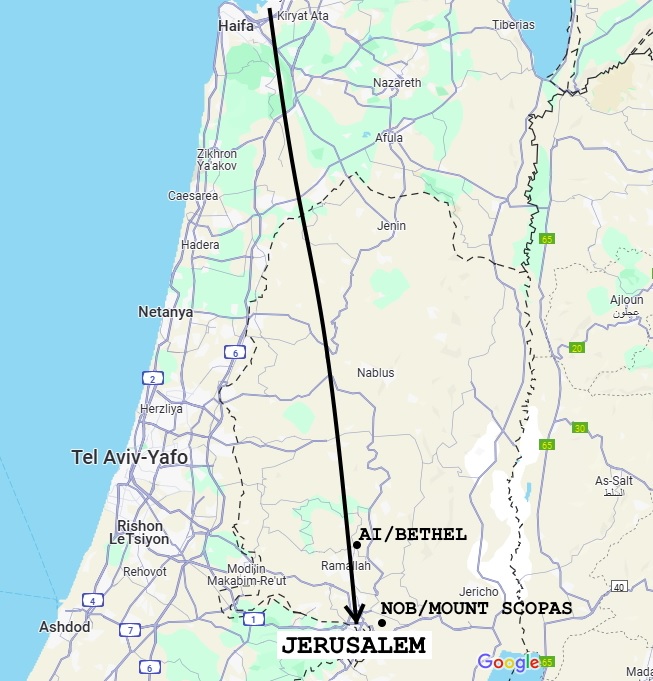
Isaiah 10: 28 – 32: He is come to Aiath, he is passed to Migron; at Michmash he hath laid up his carriages: They are gone over the passage: they have taken up their lodging at Geba; Ramah is afraid; Gibeah of Saul is fled. Lift up thy voice, O daughter of Gallim: cause it to be heard unto Laish, O poor Anathoth. Madmenah is removed; the inhabitants of Gebim gather themselves to flee. As yet shall he remain at Nob that day: he shall shake his hand against the mount of the daughter of Zion, the hill of Jerusalem.
It is always a good thing to compare what we already know concerning Armageddon with other scriptures in the Bible, as they provide extra colour and allow us to more deeply understand the events that transpire at that time. In Isaiah chapter ten, we are given a more detailed glimpse as to the path the armies of the Beast will take as they advance on Jerusalem, and how the Lord Jesus will intervene and deliver Israel from annihilation when He returns to the earth in His corporal body accompanied by His Bride of seven church ages (Revelation 19: 11 – 14).
The Antichrist or Man of Sin is called “the Assyrian” in Isaiah 10, for the prophet was speaking of a time in the far distant future when the ancient rod of chastisement (Assyria [Isaiah 10: 5]) upon Israel would be used again to chastise Israel in the last days. The Assyrian empire is of course long gone, having fallen many centuries ago, but the same spirit that was upon Assyria is still here on the earth, and will anoint the Man of Sin to bring his armies into the Middle East and descend upon Israel with them.
Assyria’s ancient conquest of Israel and the path it took to reach Jerusalem is very different from the path the Antichrist will take, for Sennacherib in passing through Israel from the north, then circled around Jerusalem and approached it from the south via Lachish, whereas the armies of the Beast make a direct approach from the north and threaten the city at Nob (Isaiah 10: 32).
This future time of great anguish upon Israel will be used by God to purify and restore Israel, but it will also be used to get the attention of the surviving remnant of Jews (Isaiah 10: 20 – 22) who will have such need of Christ for deliverance at that time. This surviving remnant are not the 144,000 Jews, for they will have been already sealed under the ministry of Moses and Elijah in the Tribulation period, after which they will be martyred. What Isaiah is seeing concerning the surviving remnant are those Jews left in Israel at Armageddon when the armies of the Beast and the armies of Russia have overrun the nation. This remnant of Jews will flee Jerusalem as the armies of the Beast approach, and the path they will take out of the city will certainly not be the route which the advancing armies are taking, for their paths will not cross.
With the Antichrist’s invasion of Israel and advance upon Jerusalem being described in Isaiah 10: 28 – 32, we then read in verses 33 and 34 that Christ will cut down these armies (likened to branches and thickets). We also learn that the nation of Lebanon will fall before Christ (the Mighty One) and be liberated from Antichrist’s occupation (Isaiah 10: 34; Psalm 29: 5), having perhaps played a significant role in the Antichrist’s attack at Armageddon.
The advance of the armies of the Beast toward Jerusalem begins in Lebanon and progresses toward Aiath or Ai, near Bethel (or Beitin today, located in the West Bank, about five kilometres northeast of Ramallah). The modern names of these ancient places can be relatively located with a little geographic research, however for the purpose of this article, we will stay with the ancient names. From Aiath the armies move on to Migron, then to Michmash where they will choose to store a lot of their equipment and weaponry. After this they will move up the pass from the valley area and will make camp at Geba. This movement of such a powerful force will make the inhabitants of Ramah (modern Ramallah in the West Bank, about 15 kilometres north of Jerusalem) to be very afraid, and the inhabitants of Gibeah, Madmenah and Gebim will pack up their belongings and evacuate these towns. Anathoth or Anata (a Palestinian town in the West Bank, about four kilometres northeast of Jerusalem) unfortunately happens to be directly in the path of the advancing force, hence Isaiah would say “O poor Anathoth!”
Upon arriving at Nob (possibly Mount Scopus today where a clear view of Jerusalem can be had), the armies of the Beast will stop and arrogantly shake their fist at the Temple Mount of Jerusalem, knowing that the city is within their grasp. Of course, Jerusalem and the Temple Mount will be taken (Zechariah 14: 1 – 2), and the Man of Sin will enthrone himself as God in the third temple (Daniel 11: 45; 2 Thessalonians 2: 3 – 4), but Christ will cut down this lofty one and cast him into the Lake of Fire (Revelation 19: 20).
